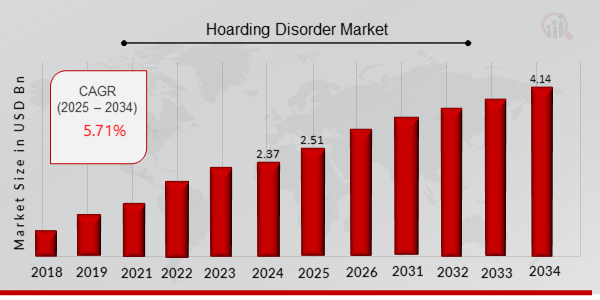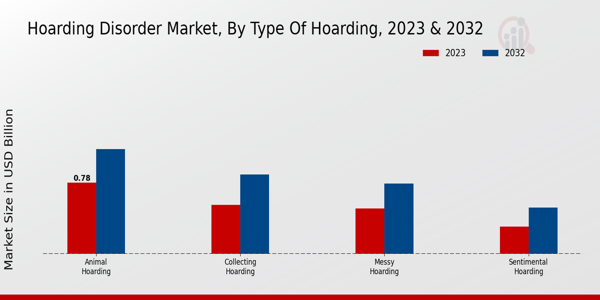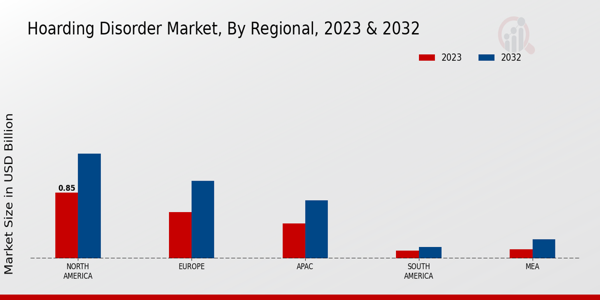Hoarding Disorder Market Overview
As per MRFR analysis, the Hoarding Disorder Market Size was estimated at 2.37 (USD Billion) in 2024. The Hoarding Disorder Market Industry is expected to grow from 2.51 (USD Billion) in 2025 to 4.14 (USD Billion) till 2034, at a CAGR (growth rate) is expected to be around 5.71% during the forecast period (2025 - 2034).
Key Hoarding Disorder Market Trends Highlighted
The Hoarding Disorder Market is experiencing notable growth due to a combination of increasing awareness about mental health and the rising prevalence of hoarding behavior as a recognized disorder. The emphasis on psychological well-being has led to more individuals seeking treatments and therapies, which in turn stimulates demand for specialized services and products in this market. Furthermore, the growing number of support groups and organizations dedicated to mental health is driving engagement and facilitating access to treatment options for those affected. There are numerous opportunities to be explored in the Hoarding Disorder Market.
Enhanced technological advancements in treatment methodologies, including online therapy and mobile applications, present new avenues for both service delivery and patient engagement. Additionally, there is potential for greater collaboration between mental health professionals and caregivers to design holistic care programs that address the various facets of the disorder. The integration of community-based support systems can also help bridge the gap for those who may be hesitant to seek help on their own. In recent times, there has been a noticeable shift in societal perceptions surrounding mental health issues, including hoarding disorder.
This changing attitude encourages more open discussions and reduces stigma, making it easier for individuals to seek help. The rise of social media platforms has further allowed individuals to share their experiences and support one another, fostering a sense of community. Awareness campaigns and educational efforts are also playing a crucial role in reaching out to the population, leading to a greater understanding of the complexities of hoarding disorder and the importance of timely intervention for those affected.

Source: Primary Research, Secondary Research, MRFR Database and Analyst Review
Hoarding Disorder Market Drivers
Increasing Awareness and Recognition of Hoarding Disorder
There has been a significant rise in awareness regarding mental health issues, particularly hoarding disorder, which is increasingly recognized as a serious psychiatric condition. The growing number of educational campaigns focusing on mental health has led to better understanding and recognition of hoarding behavior among the general public and healthcare professionals. This heightened awareness is crucial as it encourages individuals suffering from hoarding disorder to seek help and treatment, thereby driving the demand for solutions within the Hoarding Disorder Market Industry.
As mental health gains global attention, the stigma associated with conditions like hoarding is being challenged, contributing to an environment where individuals feel more comfortable disclosing their challenges and seeking effective interventions. Furthermore, this increased awareness is prompting policymakers and healthcare providers to develop new frameworks for treatment options tailored to hoarding disorder. The mental health sector is responding to this need by introducing specialized therapies, support groups, and treatment plans, directly contributing to the growth of the Hoarding Disorder Market.
As more mental health professionals are trained in recognizing and treating hoarding alongside other mental disorders, the pathways to treatment become clearer, fostering an environment that promotes recovery and management.
Development of Specialized Treatment Programs
The Hoarding Disorder Market Industry is witnessing the emergence of specialized treatment programs designed to address the unique challenges associated with hoarding disorder. Mental health practitioners and organizations are increasingly developing tailored approaches that include cognitive-behavioral therapy, support groups, and family therapy options. These specialized programs not only cater to individuals' psychological needs but also incorporate practical solutions for decluttering and managing possessions.
With comprehensive treatment plans now available, the likelihood of recovery improves significantly, leading to a growing demand for such services.
Technological Advancements in Therapy Delivery
The rise of telehealth services and digital therapeutic platforms is shaping the Hoarding Disorder Market Industry by providing easier access to treatment resources. Through online therapy sessions, individuals can receive guidance from professionals without the barriers of geographical location or mobility issues. This technological shift allows for more consistent follow-up and monitoring of patients, enhancing treatment efficacy. As technology continues to integrate into mental health care, it creates a broader reach for those struggling with hoarding disorder, leading to increased market growth.
Hoarding Disorder Market Segment Insights:
Hoarding Disorder Market Type of Hoarding Insights
The Hoarding Disorder Market is experiencing notable growth, particularly focusing on the Type of Hoarding segment, which is contributing significantly to the overall market revenue. In 2023, the total market is valued at 2.12 USD Billion, with each type of hoarding playing a crucial role in this valuation. Among the various types of hoarding, Animal Hoarding stands out with a valuation of 0.78 USD Billion, projected to rise to 1.15 USD Billion by 2032. This highlights the significant concern surrounding animal welfare and the mental health implications associated with such behaviors, as individuals often struggle to provide adequate care for the animals they accumulate.
Collecting Hoarding follows closely, valued at 0.54 USD Billion in 2023 and expected to grow to 0.87 USD Billion by 2032. This type often includes collectibles that can hold personal value, thus enhancing its emotional connection for individuals, which adds complexity to treatment options. Messy Hoarding is another prominent category, holding a market value of 0.50 USD Billion in 2023, with projections indicating an increase to 0.77 USD Billion by 2032. This type often leads to significantly cluttered living conditions, which can be hazardous both physically and mentally for the individual.
Finally, Sentimental Hoarding, although valued at a lower 0.30 USD Billion in 2023, shows growth potential with a forecasted value of 0.51 USD Billion by 2032. This hoarding type emphasizes emotional attachments to objects, complicating decluttering efforts and creating barriers to treatment. The increasing awareness of mental health issues surrounding hoarding behavior, along with the rising number of individuals seeking help, underscores the importance of addressing the different facets of the Hoarding Disorder Market. The market growth is driven by evolving therapies, increasing acceptance of mental health conditions, and a growing understanding that hoarding can affect various aspects of life, leading to a myriad of opportunities for treatment and support services in the industry.
Each Type of Hoarding offers unique challenges and requires specific attention, indicating a need for tailored approaches in both treatment methods and market strategies. As the Hoarding Disorder Market continues to develop, understanding the statistics and dynamics of each type of hoarding remains critical for stakeholders looking to navigate this complex landscape effectively.

Source: Primary Research, Secondary Research, MRFR Database and Analyst Review
Hoarding Disorder Market Treatment Method Insights
The Hoarding Disorder Market is projected to reach a valuation of 2.12 USD Billion in 2023, reflecting a significant demand for effective treatment methods aimed at addressing the complexities of this condition. Within the treatment method segment, cognitive behavioral therapy is a critical approach, focusing on modifying unhelpful beliefs and behaviors associated with hoarding. Medication also plays an essential role, particularly in managing concurrent symptoms such as anxiety and depression, which are often present in individuals with hoarding disorder.
Furthermore, support groups have emerged as an important resource, offering shared experiences and fostering a sense of community among affected individuals. Finally, family therapy is significant as it involves loved ones in the treatment process, helping to create a supportive environment for recovery. The diversity within the treatment methods underscores the multifaceted nature of hoarding disorder, highlighting the need for tailored interventions that cater to individual needs. The Hoarding Disorder Market revenue is anticipated to exhibit growth, supported by increasing awareness and advances in therapeutic techniques aimed at effectively managing this challenging condition.
Hoarding Disorder Market Age Group Insights
The Hoarding Disorder Market is expected to reach a valuation of 2.12 billion USD in 2023, highlighting the growing awareness and treatment avenues for this condition across different age groups. The market segmentation regarding Age Group reveals distinct trends and characteristics that reflect the prevalence of hoarding behaviors among varied demographics. Children and Adolescents are increasingly being identified as important focus areas, as early intervention can significantly reduce the risk of severe outcomes later in life. Adults represent the majority holding within the market, often facing substantial challenges such as occupational impairments and strained relationships, making their treatment vital.
The Elderly also dominate this segment, as age-related factors can exacerbate hoarding tendencies, further complicating their living conditions and overall well-being. The Hoarding Disorder Market data indicates a pronounced growth trajectory influenced by various drivers, including increased societal awareness, advancements in therapeutic techniques, and emerging digital platforms for support and education. However, the market does face challenges such as stigma, lack of resources, and varying levels of acceptance within families and communities, presenting both challenges and opportunities for future advancements in therapeutic solutions.
Hoarding Disorder Market Diagnosis Method Insights
The Hoarding Disorder Market is experiencing significant growth, driven by an increasing awareness of mental health issues and a rising rate of diagnosis. In 2023, the market was valued at 2.12 USD Billion, with expectations for continued expansion driven by factors such as improved screening methods and growing access to mental health services. Within this market, the Diagnosis Method category showcases a variety of approaches, including Clinical Interview, Self-Reporting Questionnaires, Family Assessment, and Observation. Clinical Interview holds an important role by allowing professionals to gather comprehensive insights into the patient's condition through direct communication, thereby fostering more accurate diagnoses.
Self-Reporting Questionnaires serve as valuable tools for individuals to express their experiences and symptoms, which streamlines the assessment process. Family Assessment is critical as it provides context surrounding the individual's environment and relationships, highlighting the social aspect of hoarding behavior. Observation is another key method, offering real-time insights into individuals' living conditions, which can be crucial for understanding the severity of the disorder. As a result, each of these approaches plays a significant role in shaping the treatment outcomes in the Hoarding Disorder Market, reflecting the need for multifaceted evaluation strategies.
Hoarding Disorder Market Regional Insights
The Hoarding Disorder Market is experiencing notable growth across various regions. In 2023, North America is leading the market with a valuation of 0.85 USD Billion, expected to rise to 1.35 USD Billion by 2032, indicating its major share and dominance in the industry. Europe follows with a substantial valuation of 0.6 USD Billion in 2023, projected to increase to 1.0 USD Billion, reflecting a significant growth trajectory. Meanwhile, the APAC region, valued at 0.45 USD Billion in 2023 and expected to reach 0.75 USD Billion by 2032, is gaining importance as awareness of mental health grows.
South America, though smaller with a valuation of 0.1 USD Billion in 2023, shows potential with a rise to 0.15 USD Billion. Lastly, the MEA region starts with 0.12 USD Billion in 2023 and is expected to reach 0.25 USD Billion, marking it as an emerging segment in the Hoarding Disorder Market. The varying market dynamics across these regions underscore regional preferences, healthcare infrastructures, and rising awareness about hoarding disorders, acting as growth drivers while presenting unique challenges.

Source: Primary Research, Secondary Research, MRFR Database and Analyst Review
Hoarding Disorder Market Key Players and Competitive Insights:
The Hoarding Disorder Market has gained significant attention in recent years due to an increasing awareness of mental health issues and the unique challenges posed by hoarding behavior. This market encompasses a diverse range of products and services aimed at assessing and treating hoarding disorder, appealing to a variety of stakeholders, including healthcare professionals, mental health facilities, and rehabilitation centers. As demand for effective therapeutic interventions grows, players in this market are innovating their offerings to ensure they meet the nuanced needs of individuals suffering from hoarding disorders. The competitive landscape of this market features numerous entities that differentiate themselves through specialized services, unique treatment methodologies, and effective outreach programs. The strategic approaches undertaken by companies to capture market share delineate a dynamically evolving environment where stakeholders are continuously adapting to emerging trends and consumer awareness.
New Horizons has established a notable presence in the Hoarding Disorder Market by focusing on comprehensive treatment strategies that are tailored to individuals. The strengths of New Horizons lie in its multidisciplinary approach, utilizing both therapeutic and practical organizing services to help clients regain control over their living spaces while addressing underlying psychological factors. The company is recognized for its evidence-based methodologies, which incorporate the latest findings in hoarding disorder treatment. Its strong emphasis on developing personalized care plans ensures better engagement and outcomes for clients, positioning New Horizons favorably in a competitive landscape. Moreover, the company’s commitment to continuous research and adaptation of treatment protocols keeps it at the forefront of advancements in the field, enhancing its credibility and service delivery.
Cognitive Care Clinic has also carved out a significant niche within the Hoarding Disorder Market through its focus on cognitive behavioral therapy and client education. This clinic prides itself on offering specialized programs that address not just the symptoms of hoarding disorder but also the underlying thought patterns and behaviors. By integrating cognitive therapies with practical skills training, Cognitive Care Clinic empowers individuals to break the cycle of hoarding. The clinic’s strengths lie in its highly trained staff and a supportive environment that fosters accountability and personal growth. Furthermore, the clinic places a strong emphasis on community involvement and awareness, contributing to reducing stigma around hoarding disorders. This proactive approach, combined with a strong reputation for delivering effective treatment options, allows Cognitive Care Clinic to maintain a competitive edge and ensure its sustained relevance in the market.
Key Companies in the Hoarding Disorder Market Include:
Hoarding Disorder Market Industry Developments
Recent developments in the Hoarding Disorder Market indicate a growing awareness and demand for specialized services. Companies such as New Horizons and Serenity Counseling have been expanding their outreach programs to help educate families and communities about hoarding tendencies, thereby increasing patient engagement. Cognitive Care Clinic and The Hoarding Institute have also introduced telehealth services, enabling easier access to therapy for clients dealing with hoarding situations. Meanwhile, the National Hoarding Coalition has emphasized the need for collaboration among various service providers, enhancing the effectiveness in treatment methodologies. There have been movements in the market, with Clear Living and Organizing Solutions likely considering strategic partnerships to improve their therapeutic offerings. In terms of financial dynamics, the valuation of companies involved in the hoarding disorder niche is rising due to increasing public awareness and mental health initiatives, positively impacting market growth. However, as of now, there have not been any recent confirmed mergers or acquisitions among the specified companies like Discovering Hope Therapy, Compassionate Care, or any others listed, suggesting a focus on organic growth strategies over consolidation in the current landscape.
Hoarding Disorder Market Segmentation Insights
| Report Attribute/Metric |
Details |
|
Market Size 2024
|
2.37 (USD Billion)
|
|
Market Size 2025
|
2.51 (USD Billion)
|
|
Market Size 2034
|
4.14 (USD Billion)
|
|
Compound Annual Growth Rate (CAGR)
|
5.71 % (2025 - 2034)
|
|
Report Coverage
|
Revenue Forecast, Competitive Landscape, Growth Factors, and Trends
|
|
Base Year
|
2024
|
|
Market Forecast Period
|
2025 - 2034
|
|
Historical Data
|
2020 - 2024
|
| Market Forecast Units |
USD Billion |
| Key Companies Profiled |
New Horizons, Cognitive Care Clinic, Serenity Counseling, Hoarding Task Force, Discovering Hope Therapy, Rehabilitative Services, Clear Living, Organizing Solutions, Pathways, The Hoarding Institute, Mental Health Associates, Mindful Healing, TherapyAid, National Hoarding Coalition, Compassionate Care |
| Segments Covered |
Type of Hoarding, Treatment Method, Age Group, Diagnosis Method, Regional |
| Key Market Opportunities |
Increasing telehealth service adoption, Rising awareness and education programs, Development of targeted therapies, Integration of AI in treatment, Expansion of support networks and resources |
| Key Market Dynamics |
increasing awareness and diagnosis, rising prevalence of mental disorders, advancements in therapeutic interventions, growing demand for personalized treatment, supportive government initiatives and policies |
| Countries Covered |
North America, Europe, APAC, South America, MEA |
Frequently Asked Questions (FAQ) :
The Hoarding Disorder Market is expected to reach a value of 4.14 USD Billion in 2034.
The expected CAGR for the Hoarding Disorder Market from 2025 to 2034 is 5.71%.
North America is projected to have the largest market share in the Hoarding Disorder Market, valued at 1.35 USD Billion by 2032.
The key segments include Animal Hoarding, Collecting Hoarding, Messy Hoarding, and Sentimental Hoarding.
The market value for animal hoarding in 2032 is anticipated to reach 1.15 USD Billion.
Some major players include New Horizons, Serenity Counseling, and the Hoarding Task Force among others.
The projected market size for messy hoarding in 2032 is estimated to be 0.77 USD Billion.
The market for sentimental hoarding is expected to grow from 0.30 USD Billion in 2023 to 0.51 USD Billion in 2032.
The market size for collecting hoarding is expected to be 0.87 USD Billion by 2032.
The expected market value for the APAC region for Hoarding Disorder Market in 2032 is projected to be 0.75 USD Billion.

















